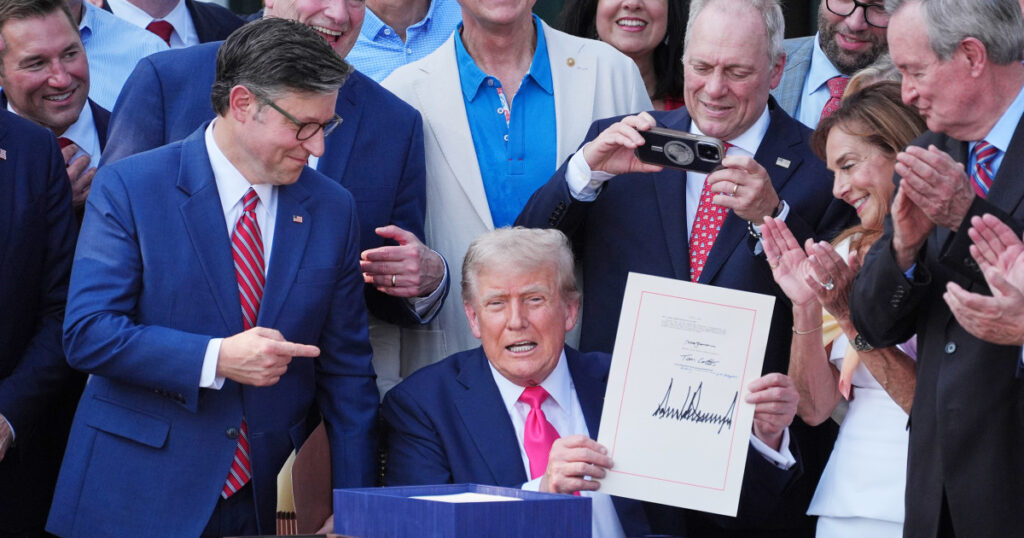Trump Officially Enacts Massive Tax and Spending Legislation on Independence Day
WASHINGTON — On Friday, President Donald Trump enacted a significant tax reduction and spending bill during a Fourth of July ceremony characterized by patriotic themes and visual festivities.
The event, held at the White House alongside a military picnic, featured a military flyover and was attended by enthusiastic Republican leaders, including House Speaker Mike Johnson and Majority Leader Steve Scalise from Louisiana. They played crucial roles in ushering the legislation through the House with a narrow margin the previous day.
“This Independence Day offers so much for our nation to celebrate as we enter our 249th year. America is thriving like never before,” Trump stated prior to signing the legislation.
He declared, “We have made the Trump tax cuts permanent. This is the most substantial tax cut in our nation’s history. We’re achieving remarkable economic milestones, and this is just the beginning. Once the bill is fully enacted, our economy is poised for explosive growth.”
The Senate approved the measure on Tuesday with a 51-50 vote, requiring Vice President JD Vance to cast the deciding vote. The House followed suit with a largely partisan vote of 218-214 on Thursday, just ahead of Trump’s set July Fourth deadline.
As the national anthem played, a B-2 Spirit bomber flew overhead, accompanied by two F-35 jets, commemorating the recent U.S. military operations against Iranian nuclear sites. Pilots involved in Operation Midnight Hammer, linked to these strikes, were present at the ceremony as special guests of the president.
Trump, joined by First Lady Melania Trump and invited guests, was expected to view the annual Independence Day fireworks display over the National Mall later Friday. Earlier in the day, he visited his Virginia golf resort.
The signing event concluded a lengthy and challenging process marked by intense debates within the House and Senate. Lawmakers grappling with whether to consolidate Trump’s domestic policy goals into one package or split them into separate bills faced disagreements. Moderates and conservatives also clashed over federal program cuts, particularly concerning Medicaid and SNAP, as well as the deduction cap for state and local taxes.
This extensive package delivers on several of Trump’s pledges for the 2024 campaign. It not only extends tax cuts from his first term in 2017 but also includes temporary reductions in taxes on tips and overtime pay and permits deductions on auto loan interest. Moreover, it allocates significant funding for military operations and advanced deportation measures.
The funding for these initiatives is partially offset by major cuts to Medicaid, SNAP, and clean energy resources.
Despite some calls from conservatives to address rising national debt levels, the new law is projected to elevate the debt by $3.3 trillion over the next decade, according to the Congressional Budget Office (CBO). Additionally, the CBO warns that 11.8 million individuals may lose health insurance as a result of the Medicaid reductions and other impacts of the legislation.
Recent polling reveals widespread disapproval of Trump’s new legislation. A Quinnipiac University survey indicates that 53% of registered voters are against the bill, while only 27% support it. Democrats are strategizing to leverage the Trump bill as a focal point for their campaigns, aiming to reclaim control of the House and potentially the Senate in the 2026 elections.
“Nothing included in Donald Trump’s one massive, troubling bill will positively impact the affordability of life for average Americans, which is one of the many reasons House Democrats oppose this legislation,” stated House Minority Leader Hakeem Jeffries, D-N.Y., during an extensive nine-hour speech opposing the bill.
Jeffries affirmed, “We are firmly against it every day; this stance will persist as we fight against measures that would disadvantage American citizens.”
Even before the ink dried on the legislation, Republicans began discussing potential modifications to the new law. While promoting the tax reductions and spending measures, Vance hinted at the possibility of revising certain policies within the package.
Trump is known for reforming policies based on their effectiveness and welcomes discussions aimed at further improvements, Vance noted during a briefing in North Dakota.
At the White House event, lawmakers vied for a position close to Trump for the photo opportunity during the signing.
Among the senators present were John Barrasso of Wyoming, Mike Crapo of Idaho, and Lindsey Graham of South Carolina. House members included Majority Whip Tom Emmer of Minnesota, Jason Smith of Missouri, and Jodey Arrington of Texas.
During the signing ceremony, Johnson presented Trump with a symbolic gavel used to enact the legislation, referring to it as “the tool that made the big, beautiful bill a reality.”

Passionate journalist and digital news editor with a keen eye for global affairs and emerging trends. As the founder and lead writer of RSS News US, he is dedicated to delivering accurate, insightful, and engaging content to readers seeking trustworthy news in a fast-paced world.


